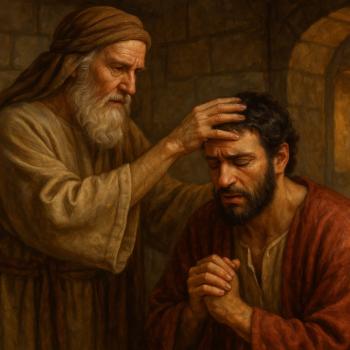What is participation in Christ? Is it the same thing as justification by faith? The late great biblical scholar E. P. Sanders would say essentially, yes. He affirms that participation in Christ and righteousness by faith “ultimately amount to the same thing” (Paul and Palestinian Judaism, p. 506). He also writes that a person participates in salvation “by becoming one person with Christ, dying with him to sin and sharing the promise of his resurrection; the transformation, however, will not be completed until the Lord returns” (p. 549: cf. 440; 522–23).
Sanders explains his notion of participation in Christ as being justified in Christ, though not with the word “justified”:
On Being “Righteoused” by Faith
Sanders prefers translating the passive use of the verb dikaioô not as “to be justified” but “to be righteoused.” The term has more to do with something that happens to individuals than simply legal acquittal (forensic justification). It means “to be changed, to be transferred from one realm to another; from sin to obedience, from death to life, from being under the law to being under grace” (Paul: A Very Short Introduction, pp. 56–57).
When sinners are “righteoused” they become “one person” with Christ, transferred and incorporated “into another person,” where there is neither “Jew nor Greek…for we are all one in Christ Jesus” (Galatians 3:28). A person is thus justified or “righteoused” by participation in Christ. The person becomes part of “the body of Christ” (pp. 57–58, 88).
Sanders claims that Paul basically coerced the judicial term “righteoused” from “declared innocent” to mean “transferred from one state to another.” This is most evident in Romans 6:7, where Paul forces “one who has been righteoused” to mean “one who by dying with Christ escapes the old creation where sin reigns… ‘Being righteoused’ means ‘dying with Christ’ and sharing his life” (Sanders, Short Introduction, pp. 88–89).
But for Sanders, the transference and incorporation is not so much about an individual being right before God. It is more about how gentiles might participate in the last days “in the people of God” (pp. 57–58). To be righteoused by faith, then, means, “‘being transferred from the group which will be destroyed to that which will be saved’. This transfer involves a change in the person, so that Christ lives in and through the believer” (p. 90).
Later on, Richard Hays took up Sanders’s influential thoughts on participation in Christ, attempting to unpack further what this means.

Real Participation in Christ
Richard Hays sets out to answer a question from Sanders about what does “real participation in Christ” mean (“What is ‘Real Participation in Christ’? A Dialogue with E. P. Sanders on Pauline Soteriology,” pp. 336-51).* His view includes four proposals for understanding participation further:
Participation as belonging to a family
For Sanders, belonging to Christ is not really different than being in Christ (Rom 8:9–10; cf. 1 Cor 6:12–20; 7:22–23; 15:23; Gal 5:24; Rom 6:15–23; 14:8–9). Hays agrees but adds the structure of an extended family to this perception. Christ is imagined as the head of a household—the master. The believers are sometimes portrayed as slaves, sometimes sons and daughters, and thus heirs (Galatians 4:7). In this way they participate in the benefits of the household (Hays, “Real Participation,” p. 340).
Hays adds to this that gentiles who are blessed “in Abraham,” as Abraham’s seed, heirs, and one in Christ (Gal 3:8, 28–29; cf. Genesis 12:3; 18:18). They are adopted into Abraham’s family and thus become recipients of divine favor that pertains thereto (pp. 340–41).
Participation as political/military solidarity with Christ
This aspect of comes “within the sphere of power of Christ’s lordship.” The metaphor here switches from familial to political or militaristic (cf. Rom 6:12–14) (p. 341). This participation in which one dies to the power of Sin through by dying with Christ in baptism (Romans 6:3–11). Christ’s death and resurrection triumphs over Sin and Death and enlists the baptized as “weapons” against Sin. The Messiah’s enthronement likewise contribute to this image (1 Cor 15:20–28; Phil 3:20–21).
Participation in the Ekklesia
The Greek term, ekklesia, often translated in our Bibles as the “church,” originally refers to an assembly of people rather than a building with steeples. For Hays, being in Christ means to be “inextricably woven together with his experience of participation in a remarkable new boundary-blurring human community made up of Jews and Gentiles together, a community where Christ’s presence was understood to be palpably manifest through the sharing of bread and wine and through the outpouring of the Spirit in communal worship” (p. 344).
We see such language from texts like 1 Corinthians 12:12–31; Romans 12:4–8; Galatians 3:27-29; and also through the Lord’s Supper in 1 Cor 11:23–26. To participate in the body of Christ “provided the setting which Paul’s soteriology [salvation -ology] took shape and made sense” (p. 345).
Participation as living within the Christ story
This point for Hays is a narrative participation related to Paul’s retelling of Israel’s story and of Jesus summoning his hearers “into a symbolic world in which cross, resurrection, and Parousia are the events that define the shape and meaning of history” (p. 345). The “story” summons a response to the hearers. Those who reject it are “perishing” and those who accept it are “being saved” (1 Cor 1:18). This story, I surmise, must be inclusive of the gospel.
We notice the identifying phrase “our fathers” embraces even Gentiles, not just Israel, in 1 Corinthians 10:1. Through “the story,” people are called to conformity to the image of Christ. The goal or telos of participation “is the conformity of the hearer’s life to the story of Jesus Christ” (p. 346). We share in the glory and sufferings of Christ’s story. To be in Christ is thus to share in the fellowship of his sufferings, conformed to his death (Phil 3:10).
My Reflections
Both Sanders and Hays draw our attention to participation in Christ as a salvation event, and Sanders is not shy about equating participation with justification (though for Sanders, the latter more appropriately should be translated as being “righteoused”).
We do notice in Scripture that when a people or person are “in Christ,” there is no condemnation for them (Romans 8:1). Also, “in Christ” the law of Spirit of life sets them free from the law of sin and death (Rom 8:2). They are a new creation “in Christ” (2 Corinthians 5:17), and “in Christ” they are made to embody the righteousness of God (2 Cor 5:21). Also, Paul even speaks about believers seeking to be justified/righteoused in Christ (Gal 2:17).
For me, justification and participation in Christ are like two sides of the same coin. They both describe the salvific event, an event that begins at conversion-initiation and culminates at the end of the age. The “not yet” events at this culmination include final judgment, and this involves forensic acquittal. As such, justification (the same Greek word as righteousness: dikaiosune) must have a forensic dimension to it. This is also experienced by the convert in the “now” as the forgiveness of sins.
Even Sanders does not deny that Paul’s terminology here is forensic; he just plays up the participatory aspect of dik- terms. Salvation is not just about being forgiven, it is also about a relationship, a personal ongoing relationship believers have with God in Christ.
Together with the Holy Spirit, through which (or whom) participation in Christ takes place, I suggest further the analogy of a musical instrument: the percussion triangle. The three sides consist of righteousness/justification, Spirit, and participation in Christ (B. J. Oropeza, “‘The Righteous by Faith Shall Live’… in the Spirit: Galatians 2:16–3:14 and Salvific Life,” in Scripture, Texts, and Tracings in Galatians and 1 Thessalonians, pp. 39–58, esp. 40).
Are you playing well with all three sides?
Notes
* The Hays article is found in Redefining First-Century Jewish and Christian Identities: Essays in Honor of Ed Parish Sanders, ed. Fabian E. Udoh; CJAS 16 (Notre Dame: University of Notre Dame, 2008), 336–51.














